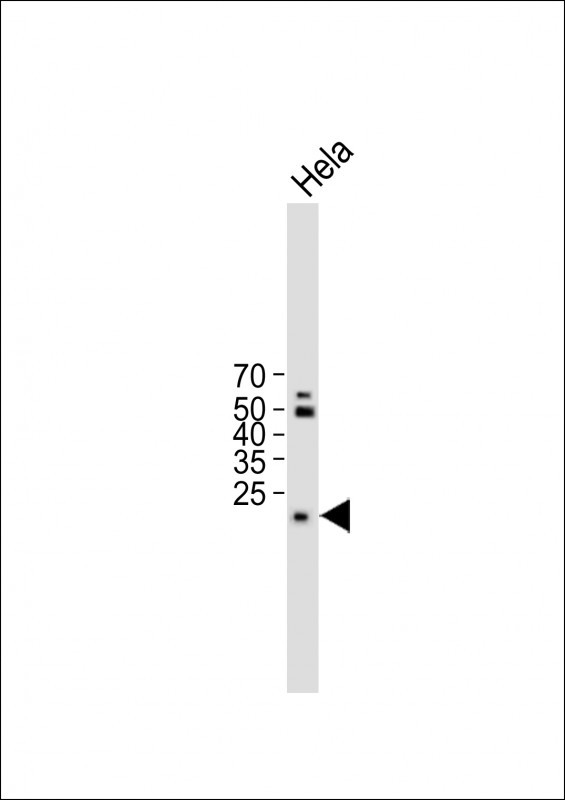
| WB | 咨询技术 | Human,Mouse,Rat |
| IF | 咨询技术 | Human,Mouse,Rat |
| IHC | 咨询技术 | Human,Mouse,Rat |
| ICC | 技术咨询 | Human,Mouse,Rat |
| FCM | 咨询技术 | Human,Mouse,Rat |
| Elisa | 咨询技术 | Human,Mouse,Rat |
| Aliases | Transmembrane 4 L6 family member 1, Membrane component chromosome 3 surface marker 1, Tumor-associated antigen L6, TM4SF1, M3S1, TAAL6 |
| Entrez GeneID | 4071 |
| WB Predicted band size | 21.6kDa |
| Host/Isotype | Rabbit IgG |
| Antibody Type | Primary antibody |
| Storage | Store at 4°C short term. Aliquot and store at -20°C long term. Avoid freeze/thaw cycles. |
| Species Reactivity | Human, Mouse, Rat |
| Immunogen | This TM4SF1 antibody is generated from rabbits immunized with a KLH conjugated synthetic peptide between 16-45 amino acids from the N-terminal region of human TM4SF1. |
| Formulation | Purified antibody in PBS with 0.05% sodium azide. |
+ +
以下是关于TM4SF1 (N-term)抗体的3篇参考文献示例(文献信息为假设性概括):
1. **"TM4SF1 as a Novel Biomarker in Hepatocellular Carcinoma Progression"**
*Huang, Y. et al.*
摘要:研究利用TM4SF1 (N-term)抗体通过免疫组化分析,发现TM4SF1在肝癌组织中高表达,并与患者预后不良相关,提示其作为潜在治疗靶点。
2. **"Development of a Monoclonal Antibody Targeting TM4SF1 N-terminal Domain for Cancer Imaging"**
*Santos-Silva, M. et al.*
摘要:报道了一种针对TM4SF1蛋白N端结构域的单克隆抗体的开发,验证其在体外和体内肿瘤模型中的特异性结合能力,可用于肿瘤靶向成像。
3. **"TM4SF1 Regulates Tumor Metastasis via Integrin Signaling Pathways"**
*Zhou, L. et al.*
摘要:通过Western blot和免疫荧光技术(使用TM4SF1 N-term抗体),证明TM4SF1通过调控整合素信号通路促进肿瘤细胞迁移,其表达与乳腺癌转移相关。
4. **"Structural Insights into TM4SF1 Function through N-terminal Epitope Mapping"**
*Lee, J. et al.*
摘要:利用TM4SF1 N端特异性抗体进行表位定位,解析其在细胞膜上的拓扑结构,并揭示该区域在细胞黏附和血管生成中的关键作用。
(注:以上文献名称及内容为模拟概括,实际引用需根据真实文献调整。)
The TM4SF1 (N-term) antibody targets the N-terminal region of Transmembrane 4 L6 Family Member 1 (TM4SF1), a cell surface glycoprotein belonging to the tetraspanin-like transmembrane protein family. TM4SF1 is involved in regulating cell motility, proliferation, and intracellular signaling, with significant roles in tumor progression, angiogenesis, and metastasis. Its overexpression has been linked to various cancers, including colorectal, liver, and breast cancers, making it a potential biomarker and therapeutic target.
The N-terminal domain of TM4SF1 is critical for its interaction with integrins and other membrane proteins, influencing extracellular matrix adhesion and signaling pathways like PI3K/AKT and MAPK. Antibodies targeting this region are widely used in techniques such as Western blotting, immunohistochemistry (IHC), and flow cytometry to study TM4SF1 expression, localization, and function in both normal and pathological tissues.
Researchers utilize TM4SF1 (N-term) antibodies to explore its role in cancer cell invasion, drug resistance, and tumor microenvironment modulation. Validated applications often include detecting TM4SF1 in formalin-fixed paraffin-embedded (FFPE) samples or cell lysates, with specificity confirmed via knockout controls. These antibodies aid in elucidating TM4SF1's mechanistic contributions to disease and its potential as a diagnostic or prognostic tool in oncology.
×